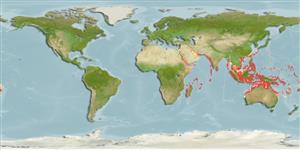Common names from other countries
Environment: milieu / climate zone / depth range / distribution range
Οικολογία
Υφαλόφιλο(α); εύρος βάθους 3 - 56 m (Ref. 8294). Tropical; 30°N - 27°S, 32°E - 172°W (Ref. 848)
Indo-West Pacific: Bonin Islands to Australia and Red Sea to Kiribati.
Length at first maturity / Μέγεθος / Βάρος / Age
Maturity: Lm ? range ? - ? cm
Maximum depth from Ref. 100940.
Life cycle and mating behavior
Γεννητική Ωρίμανση | Αναπαραγωγή | Γεννοβολία | Αβγά | Γονιμότητα | Προνύμφες
Mature gametes are shed into the coelenteron and spawned through the mouth. Life cycle: The zygote develops into a planktonic planula larva. Metamorphosis begins with early morphogenesis of tentacles, septa and pharynx before larval settlement on the aboral end (Ref. 833).
Ross, M.A. and G. Hodgson. 1981. (Ref. 8294)
IUCN Red List Status (Ref. 130435: Version 2024-1)
CITES status (Ref. 108899)
Not Evaluated
Human uses
| FishSource |
Εργαλεία
Περισσότερες πληροφορίες
Age/SizeΑύξησηLength-weightLength-lengthΜορφολογίαΠρονύμφεςΑφθονία
Διαδικτυακές πηγές
Estimates based on models
Preferred temperature
(Ref.
115969): 25.4 - 29.3, mean 28.5 (based on 3105 cells).
Price category
Unknown.
